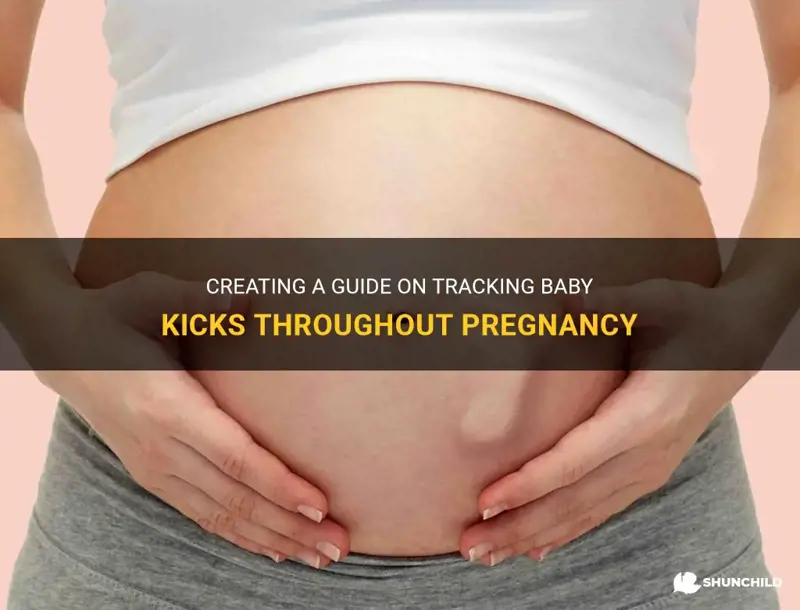
During pregnancy, feeling your baby's movements is not only an exciting experience but also a key indicator of your baby's well-being. Counting baby kicks can help monitor your baby's activity levels and ensure their healthy development. By paying attention to these tiny movements, you can develop a deeper connection with your little one even before they enter the world. So, let's dive into the art of counting baby kicks and discover the various ways to track these precious moments during pregnancy.
| Characteristics | Values |
|---|---|
| Frequency | 10 |
| Time of day | Any |
| Position | Lying down, sitting up, or standing |
| Duration | 1 to 2 hours |
| Counting method | Count every kick, flutters, rolls, and jabs |
| Tracking | Use a kick counting chart or app |
| Recording | Write down the start and end time, add up the total kicks |
| Concerns | Contact healthcare provider if there is a significant decrease in kicks or no movement for several hours |
What You'll Learn
- What are the recommended guidelines for counting baby kicks during pregnancy?
- How often should I count my baby's kicks, and at what time of day?
- What qualifies as a kick when counting fetal movements?
- What should I do if I'm not feeling my baby move as frequently as usual?
- Are there any tools or apps available to help me track my baby's kicks?

What are the recommended guidelines for counting baby kicks during pregnancy?
Counting baby kicks during pregnancy is an important monitoring technique that can provide valuable insight into the baby's health and well-being. It can help detect any potential issues or complications early on and ensure timely medical intervention if necessary. Understanding the recommended guidelines for counting baby kicks can help pregnant women feel more confident in monitoring their baby's movements and ensure a healthy pregnancy.
Why count baby kicks?
Counting baby kicks is a way to measure the baby's daily movements, also known as fetal movement. It is a simple technique that can be performed by any pregnant woman without requiring any special equipment. The number of kicks and their frequency can vary between pregnancies, but it is essential to establish a baseline for determining what is normal for individual moms and babies.
When should the counting begin?
Monitoring fetal movement should begin when the mother starts feeling regular movements, which is typically around 18 to 25 weeks of pregnancy. If this is the first pregnancy, it might take a little longer for the mother to recognize and differentiate fetal movements from other sensations. It is recommended to start counting once movements become consistent and are felt on a daily basis.
How to count baby kicks?
To count baby kicks, it is recommended to find a comfortable and quiet place where the mother can focus on the baby's movements. Some prefer to lay on their side or sit in a reclined position. The mother should pay attention to how long it takes to feel ten discrete movements such as kicks, rolls, or jabs. Each individual movement counts as one, and hiccups should not be included in the count.
When should the baby kicks be counted?
The best time to count baby kicks is usually in the evening or after a meal when the mother is more relaxed and the baby tends to be more active. The mother should aim for ten movements within two hours, but it is not necessary to feel ten movements in a specific timeframe. The key is consistency in the baby's regular pattern of movement rather than the exact timeframe.
What should be considered normal?
Normal fetal movement patterns can vary, but most healthy babies have a consistent pattern of movement. Some babies are more active during certain times of the day, while others have a more even distribution of movements throughout the day. However, a sudden decrease in movements or a complete absence of movement for an extended period of time should always be reported to a healthcare provider.
How to track baby kicks?
Keeping a journal or using a mobile app specifically designed for tracking fetal movements can be helpful in documenting the frequency and duration of baby kicks. This record can provide valuable information for healthcare providers and help detect any potential issues. If a change in the baby's regular pattern of movements is noted, it is important to discuss it with a healthcare provider.
In conclusion, counting baby kicks is an essential practice during pregnancy to monitor the baby's well-being. Following the recommended guidelines, including starting at the right time, counting in a relaxed environment, and maintaining a consistent pattern, can help ensure a healthy pregnancy. If any concerns arise, it is crucial to consult a healthcare provider for further evaluation and guidance.
The Romantic Connection: Exploring the Frequency of Valentine's Day Baby Births
You may want to see also

How often should I count my baby's kicks, and at what time of day?
Counting your baby's kicks during pregnancy is an important way to monitor their health and well-being. Kick counting is a simple and effective method used to assess fetal movement, which can indicate their overall health and ensure that they are developing normally. Let's explore how often you should count your baby's kicks and at what time of day.
The American College of Obstetricians and Gynecologists recommends counting your baby's kicks starting at around 28 weeks of gestation. This is when the baby's movements become more pronounced and can easily be felt. However, it's important to note that every pregnancy is different, and some women may start feeling their baby's movements earlier or later.
In general, it is advisable to count your baby's kicks once a day, at a time when your baby is usually active. This activity peak can vary from woman to woman but tends to be more common in the late afternoon or evening. Take note of the time when your baby is most active, and use that as a guide for when to count their kicks.
To count your baby's kicks, find a comfortable position, either sitting or lying down, where you can focus on feeling their movements. Pay attention to every movement, including kicks, rolls, jabs, and flutters. Use a kick chart or a notepad to keep track of the number of movements within a specific time frame, usually an hour.
The general guideline is to feel at least 10 movements within one to two hours. However, it's crucial to remember that every baby is different, and their movement patterns may vary. Some babies are naturally more active, while others may have quieter periods. The key is to look for trends and changes in their movement patterns. If you notice a significant decrease in your baby's movements or a sudden change in their activity level, contact your healthcare provider immediately.
It's worth mentioning that factors such as caffeine intake, physical activity, and the position of your baby can affect their movement. If you've had a cup of coffee, engaged in vigorous exercise, or are experiencing a busy day where you may not be as aware of your baby's movements, these can all contribute to fewer perceived kicks. However, it's essential to maintain a consistent routine of kick counting to have a better understanding of your baby's normal activity level.
In conclusion, counting your baby's kicks during pregnancy is an effective way to monitor their well-being. It is recommended to count their kicks once a day, preferably at a time when your baby is typically active. Keep track of their movements using a kick chart, aiming to feel at least 10 movements within one to two hours. Trust your instincts and reach out to your healthcare provider if you have concerns about your baby's movement patterns. Remember, counting kicks provides valuable insights into your baby's health and strengthens the bond between you and your little one.

What qualifies as a kick when counting fetal movements?
Counting fetal movements, also known as kick counting, is an important practice during pregnancy to monitor the baby's well-being. By keeping track of the baby's movements, expectant mothers can identify any potential issues early on and seek medical attention if needed. However, it is crucial to know what qualifies as a kick when counting fetal movements to ensure accurate monitoring.
When it comes to defining a fetal kick, it is essential to understand that it includes any movement felt by the mother. Fetal movements can vary greatly in intensity and type, ranging from gentle flutters to more pronounced punches and rolls. Some common types of movements include kicks, jabs, rolls, stretches, and hiccups.
Here are a few key factors to consider when determining whether a movement qualifies as a fetal kick:
- Frequency: It is recommended to count at least 10 movements within a two-hour period. However, different healthcare providers may have slightly varying guidelines, so it is advisable to check with your healthcare provider for specific instructions.
- Strength: Although not all fetal movements will be forceful, they should generally be distinct enough to be felt by the mother. A slight poke or flutter can also count as a kick if it meets the frequency criteria mentioned above.
- Consistency: It is important to pay attention to the consistency of movements. If there is a sudden decrease or complete absence of fetal movements, it is crucial to contact your healthcare provider immediately, as it may indicate a potential problem.
- Patterning: While fetal movements may not have a rhythmic pattern, it is common for babies to have periods of increased activity and periods of rest. It is essential to be aware of your baby's usual patterns and report any significant changes to your healthcare provider.
- Variability: Every pregnancy and baby is unique, so the frequency and strength of fetal movements can vary. However, it is not advisable to compare your baby's movements to someone else's experience or rely solely on online forums and anecdotes. Trust your own perception and seek advice from your healthcare provider if you have any concerns.
Counting fetal movements should be a mindful and active practice for expectant mothers. Here is a step-by-step guide on how to effectively count fetal movements:
- Choose a time when your baby is usually active, such as after meals or when you are resting.
- Find a comfortable position, either sitting or lying down, where you can focus on the baby's movements without distractions.
- Use a notebook, smartphone app, or a chart provided by your healthcare provider to record the time you start counting.
- Pay attention to your baby's movements and begin the count whenever you feel the first kick or movement.
- Continue counting every movement you feel until you reach a count of 10. Note down the time you felt the 10th movement.
- If you don't feel 10 movements within two hours, try changing your position, eating a snack, or drinking some water to see if it stimulates the baby's movement. If you are still unable to reach 10 movements within the recommended time frame, contact your healthcare provider.
Remember, kick counting is not intended to be a source of stress or anxiety, but rather a way to actively participate in the monitoring of your baby's health. It is important to rely on your personal experience and consult with your healthcare provider if you have any concerns about your baby's movements.
In conclusion, any movement felt by the mother can qualify as a fetal kick when counting fetal movements. The frequency, strength, consistency, patterning, and variability of movements should be taken into consideration. By following the recommended guidelines and being aware of your baby's usual patterns, you can ensure accurate monitoring of your baby's well-being during pregnancy.
Timing of GBS Testing during Pregnancy: What You Need to Know
You may want to see also

What should I do if I'm not feeling my baby move as frequently as usual?
If you're not feeling your baby move as frequently as usual, it can be a cause for concern. Feeling your baby move is a reassuring sign that they are active and healthy. However, it's important to remember that every pregnancy is different, and the pattern of fetal movements can vary.
Here are some steps you can take if you're not feeling your baby move as much as you used to:
- Pay attention to your baby's patterns: It's helpful to understand your baby's usual patterns of movement. Some babies are naturally more active at certain times of the day, while others may have more active periods followed by periods of rest. Monitor these patterns and note any changes.
- Change your position: Sometimes, your baby may be in a position that makes it harder for you to feel their movements. Try changing your position, whether it's sitting up straight, lying down on your left side, or gently prodding your belly to encourage movement. This can help reposition the baby and allow for better sensation of their movements.
- Drink something cold or sugary: A cold drink or something sweet like juice can stimulate the baby and encourage movement. The sudden change in temperature or the sugar rush can often get them moving around.
- Create a calm environment: Sometimes, babies are more active when the mother is relaxed and calm. Find a quiet place, lie down, take some deep breaths, and focus on your baby. Play some soft music or talk to them, which may stimulate movement.
- Count the kicks: If you're not feeling your baby move as often, you can start counting their kicks. This involves monitoring the time it takes for you to feel ten distinct movements. It's recommended to feel ten movements in less than two hours. If you're not reaching this count, contact your healthcare provider.
- Seek medical advice: If you're still concerned about your baby's movements, it's essential to reach out to your healthcare provider. They can provide further guidance and may recommend additional tests, such as a non-stress test or ultrasound, to ensure your baby's well-being.
It's crucial to trust your instincts as a mother. If something doesn't feel right or you have any concerns about your baby's movements, don't hesitate to seek medical advice. Remember, each pregnancy is unique, and what matters most is that you and your baby receive the appropriate care and attention throughout this beautiful journey.
Ayurvedic Methods for Confirming Pregnancy: A Comprehensive Guide
You may want to see also

Are there any tools or apps available to help me track my baby's kicks?
One of the most exciting and reassuring moments during pregnancy is feeling your baby's movements, also known as kicks. Feeling those tiny flutters and kicks is a sign that your baby is healthy and growing, and it can help you bond with your little one even before they are born. In recent years, several tools and apps have been developed to help expectant parents track their baby's kicks and ensure that they are meeting the recommended daily movements. Let's take a closer look at some of these tools and apps and how they can be beneficial.
Kick Counter Apps:
Kick counter apps are a convenient way to track your baby's movements. These apps allow you to record each kick or movement, keeping a log of the frequency and intensity. Some apps even provide statistical analysis, showing you a graphical representation of your baby's movements over time. By using a kick counter app, you can easily monitor whether your baby is reaching the recommended number of daily movements, which is typically around 10 kicks within a specified time frame.
Wearable Kick Trackers:
Wearable kick trackers are devices that can be attached to your belly to monitor your baby's movements. These trackers use sensors to detect movements and transmit the data to a smartphone app or a dedicated device. They provide real-time feedback on your baby's kicks and can alert you if there is a decrease in movement. These trackers are especially useful if you want a hands-free option to keep track of your baby's movements throughout the day.
Baby Movement Monitors:
Baby movement monitors are designed to be placed under your mattress or attached to your belly to monitor your baby's movements while you sleep. These monitors use sensors to detect movements and can alert you if there is a significant decrease in movement. While these monitors are primarily used for monitoring fetal movement during sleep, they can also be useful for tracking your baby's movements throughout the day.
Using a tool or app to track your baby's kicks can provide peace of mind and help you identify any changes in your baby's movement patterns that may require further medical attention. However, it's important to remember that these tools and apps should not replace regular prenatal check-ups or medical advice. If you have concerns about your baby's movements, always consult with your healthcare provider.
In conclusion, tools and apps are available to help you track your baby's kicks, providing a convenient way to monitor their movements and ensure they are meeting the recommended daily movements. Kick counter apps, wearable kick trackers, and baby movement monitors are just a few options available. These tools can offer reassurance and help you bond with your baby even before their arrival. However, it's essential to consult with your healthcare provider if you have any concerns about your baby's movements.
The Importance of Understanding Baby Breath During Pregnancy
You may want to see also
Frequently asked questions
To count your baby's kicks during pregnancy, find a time when your baby is most active, such as after a meal or when you are relaxed. Sit or lie on your side and start counting the kicks. Every time you feel the baby move, count it as one kick. Aim to feel at least 10 kicks within a two-hour period.
It is generally recommended to start counting your baby's kicks during the third trimester of pregnancy, around 28 weeks. This is because by this time, your baby's movements will be more noticeable and regular. However, if you have a high-risk pregnancy or have been advised by your healthcare provider to monitor your baby's movements earlier, you can start counting kicks earlier in your pregnancy.
If you are not feeling enough kicks during pregnancy, it is important to contact your healthcare provider. They can provide guidance and may recommend further monitoring or testing to ensure the well-being of your baby. Remember that every baby is different, so try not to compare your experience to others. Trust your instincts and seek medical advice if you have any concerns about your baby's movements.







